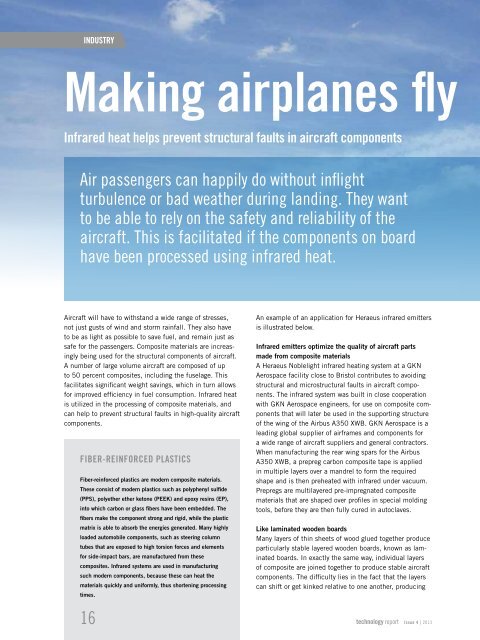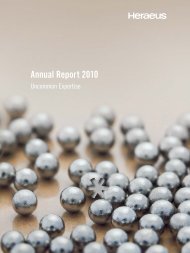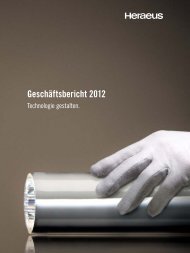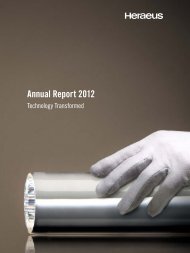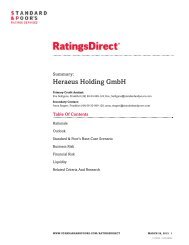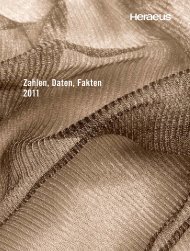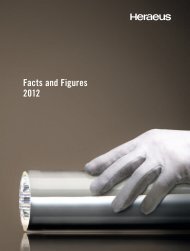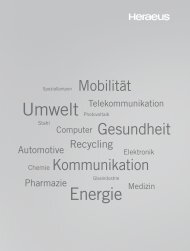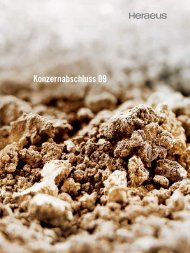technology report 04
technology report 04
technology report 04
You also want an ePaper? Increase the reach of your titles
YUMPU automatically turns print PDFs into web optimized ePapers that Google loves.
INDUSTRy<br />
Making airplanes fly<br />
Infrared heat helps prevent structural faults in aircraft components<br />
Air passengers can happily do without inflight<br />
turbulence or bad weather during landing. They want<br />
to be able to rely on the safety and reliability of the<br />
aircraft. This is facilitated if the components on board<br />
have been processed using infrared heat.<br />
Aircraft will have to withstand a wide range of stresses,<br />
not just gusts of wind and storm rainfall. They also have<br />
to be as light as possible to save fuel, and remain just as<br />
safe for the passengers. Composite materials are increasingly<br />
being used for the structural components of aircraft.<br />
A number of large volume aircraft are composed of up<br />
to 50 percent composites, including the fuselage. This<br />
facilitates significant weight savings, which in turn allows<br />
for improved efficiency in fuel consumption. Infrared heat<br />
is utilized in the processing of composite materials, and<br />
can help to prevent structural faults in high-quality aircraft<br />
components.<br />
Fiber-reinforced plastics<br />
Fiber-reinforced plastics are modern composite materials.<br />
These consist of modern plastics such as polyphenyl sulfide<br />
(PPS), polyether ether ketone (PEEK) and epoxy resins (EP),<br />
into which carbon or glass fibers have been embedded. The<br />
fibers make the component strong and rigid, while the plastic<br />
matrix is able to absorb the energies generated. Many highly<br />
loaded automobile components, such as steering column<br />
tubes that are exposed to high torsion forces and elements<br />
for side-impact bars, are manufactured from these<br />
composites. Infrared systems are used in manufacturing<br />
such modern components, because these can heat the<br />
materials quickly and uniformly, thus shortening processing<br />
times.<br />
16<br />
An example of an application for Heraeus infrared emitters<br />
is illustrated below.<br />
Infrared emitters optimize the quality of aircraft parts<br />
made from composite materials<br />
A Heraeus Noblelight infrared heating system at a GKN<br />
Aerospace facility close to Bristol contributes to avoiding<br />
structural and microstructural faults in aircraft components.<br />
The infrared system was built in close cooperation<br />
with GKN Aerospace engineers, for use on composite components<br />
that will later be used in the supporting structure<br />
of the wing of the Airbus A350 XWB. GKN Aerospace is a<br />
leading global supplier of airframes and components for<br />
a wide range of aircraft suppliers and general contractors.<br />
When manufacturing the rear wing spars for the Airbus<br />
A350 XWB, a prepreg carbon composite tape is applied<br />
in multiple layers over a mandrel to form the required<br />
shape and is then preheated with infrared under vacuum.<br />
Prepregs are multilayered pre-impregnated composite<br />
materials that are shaped over profiles in special molding<br />
tools, before they are then fully cured in autoclaves.<br />
Like laminated wooden boards<br />
Many layers of thin sheets of wood glued together produce<br />
particularly stable layered wooden boards, known as laminated<br />
boards. In exactly the same way, individual layers<br />
of composite are joined together to produce stable aircraft<br />
components. The difficulty lies in the fact that the layers<br />
can shift or get kinked relative to one another, producing<br />
<strong>technology</strong> <strong>report</strong> Issue 4 | 2013


